Bright Sun, Cold Winter
Kareem–Anthony Ferreira in Conversation with Odessa Paloma Parker
Kareem–Anthony Ferreira recently sat down to speak with writer Odessa Paloma Parker to discuss his current exhibition Bright Sun, Cold Winter for her newsletter Opaloma. We’ve replublished the interview below.
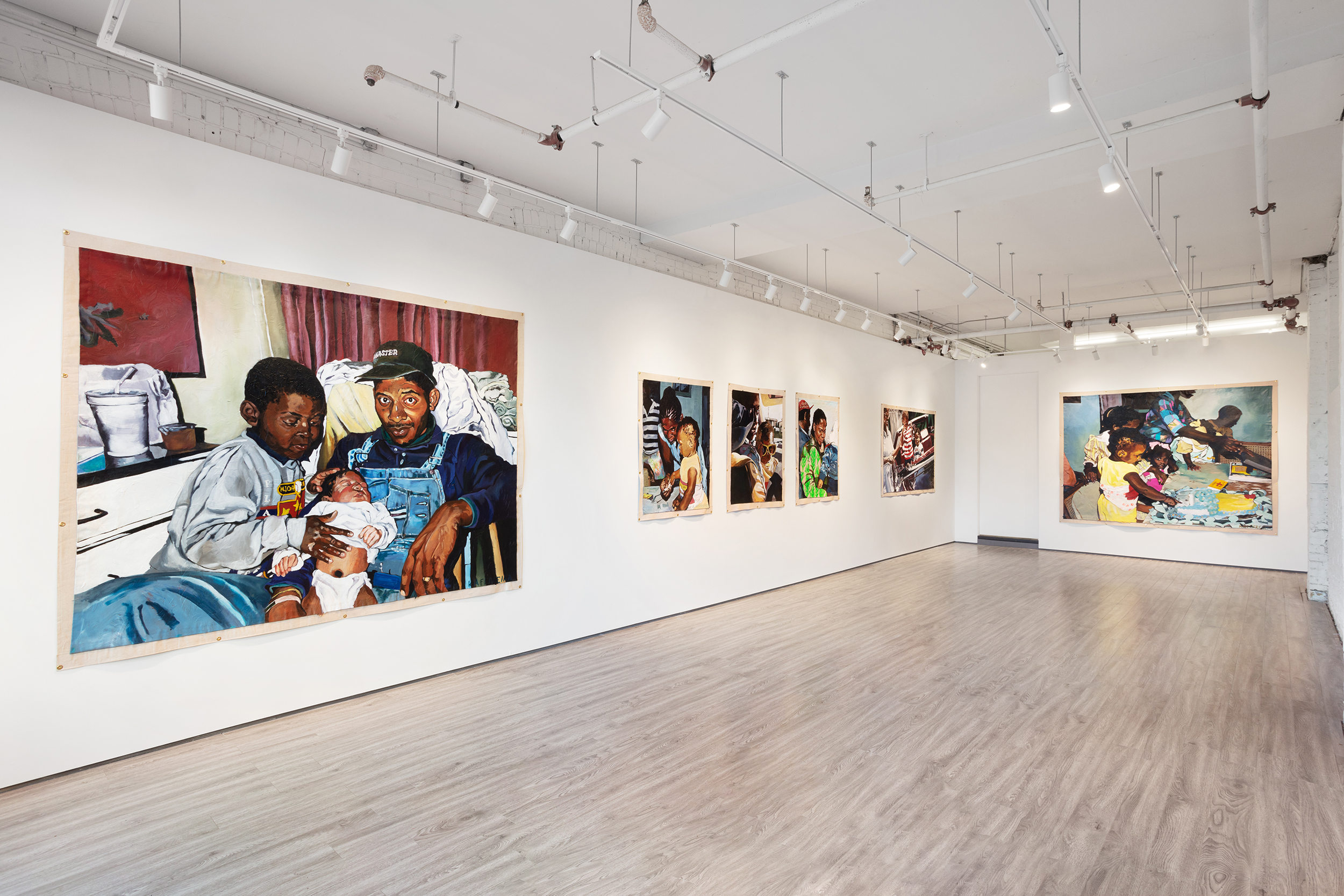
When I went to see mixed-media artist Kareem-Anthony Ferreira’s stunning show at Towards the other week, it was on one of the first mild sunny days of the season. The kind of day that makes you understand his exhibition’s title, Bright Sun, Cold Winter. The name of the show elicits feelings of hopefulness and gratitude, remembrance and anticipation; and Ferreira’s animated canvases boasting renderings of old family photos realized through acrylic and subtly texturized with painted-over collaged patterns, draw you into their scenes with a beckoning warmth.
The show’s text highlights that in one piece called October of 93, which depicts the artist as a child standing alongside his newly born baby brother and father, “Ferreira masterfully captures the casual intimacy of this occasion, highlighting a moment that is simultaneously both profound and commonplace all at once.” It’s this reverently nostalgic gaze that charges these works with a gentle magnetism – and here, Ferreira shares more about his practice, the pieces in this show, and what he’s planning next.
Odessa Poloma Parker: I want to start off by talking about the title of the show. It’s the kind of name that really hits you. Like, you know exactly the kind of feeling it conjures.
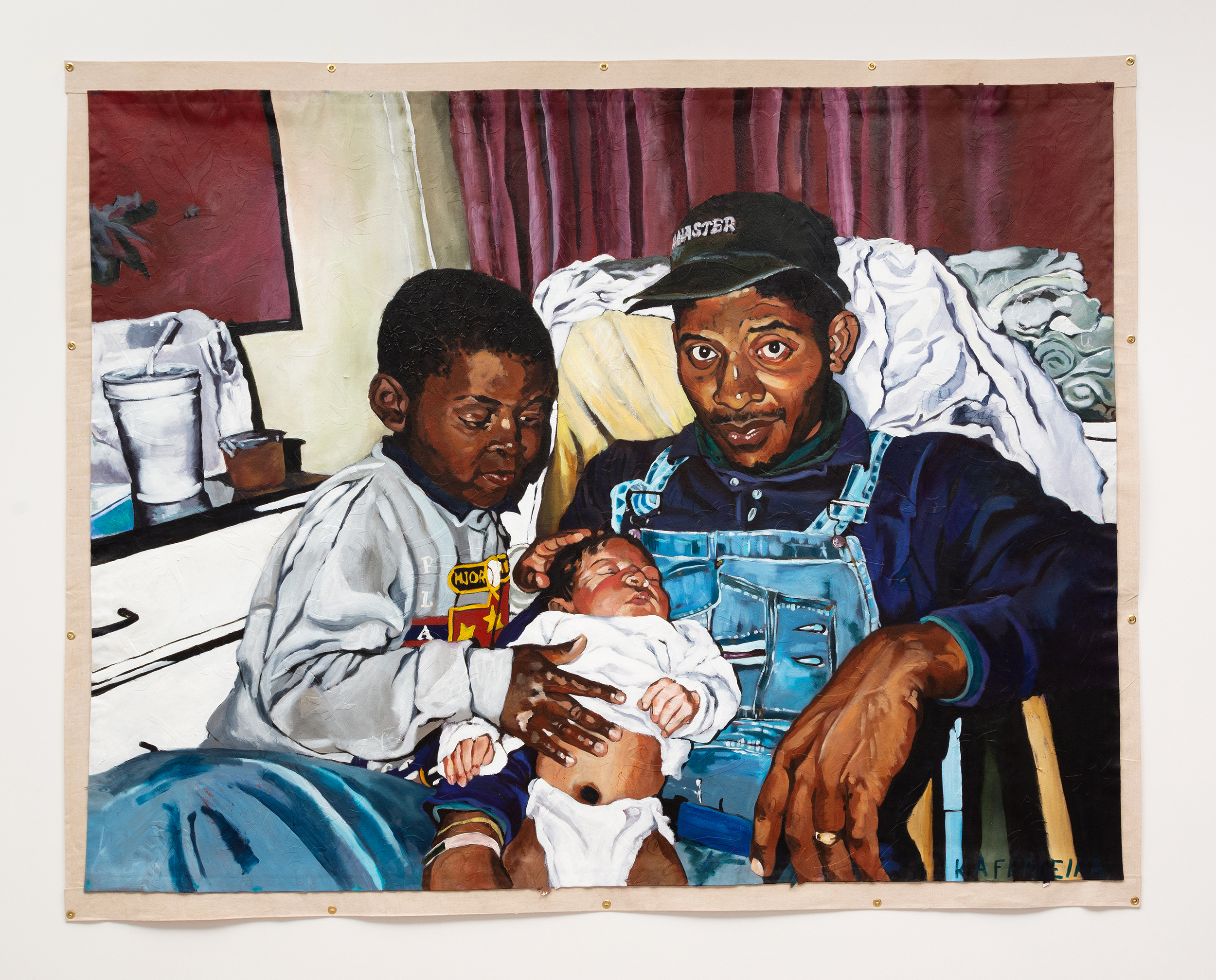
Acrylic and mixed media on canvas
72.5 in. x 91 in.
Kareem–Anthony Ferreira: The theme of the show stems from the first couple of years after my parents immigrated here. My work derives from a history of being from two places at once – growing up in Canada, and my family being from Trinidad. These pieces tell a story about those first moments of arriving…the nervousness of checking out the landscape and learning what it means to be in Canada and so far away from family. And understanding what it will take to survive and raise me and my brothers.
The title came from talking to my dad about the images that I pulled out for the pieces. My parents immigrated in December 1988, and it was a very new experience for them to come from a tropical country in the middle of winter. He said it wasn’t until the sun came out in the early Spring that they took a deep breath and were like, okay, we can do this. We can live here.
Tell me more about your family – how do they feel about being featured in your work?
For the most part, my family loves seeing themselves in the work. They ask to be in it [laughs].
My dad is also an artist, and he was in the art program at McMaster that I ended up going into. I learned from him and got my footing seeing him pursue his career. My parents have always been supportive and wanted the best for us. After having given up their home to give us a better life there was an inherent pressure on us to make something out of it, but at the end of the day, it was more about us picking something and committing to it.
I started focusing on my family as subjects after doing my undergrad. Throughout that time, I was doing work that I wasn’t really connecting with. After graduating, I took a break and pursued a teaching degree, but it ultimately wasn’t what I wanted to do. I entered into an artist residency, and one of the things I wanted to accomplish while there was fleshing out ideas of theme and meaning behind the work. One of my mentors, Gregory Coates, told me to look to my family for inspiration. In that process, I started picking through old photos and saw stories emerge that people can connect to no matter their race or age. You see these kinds of stories across all countries – of people immigrating and starting anew and having a kind of identity crisis. They now live in a place, but they grew up somewhere else and the majority of their family lives somewhere else. There are these dual lives that they’re living.
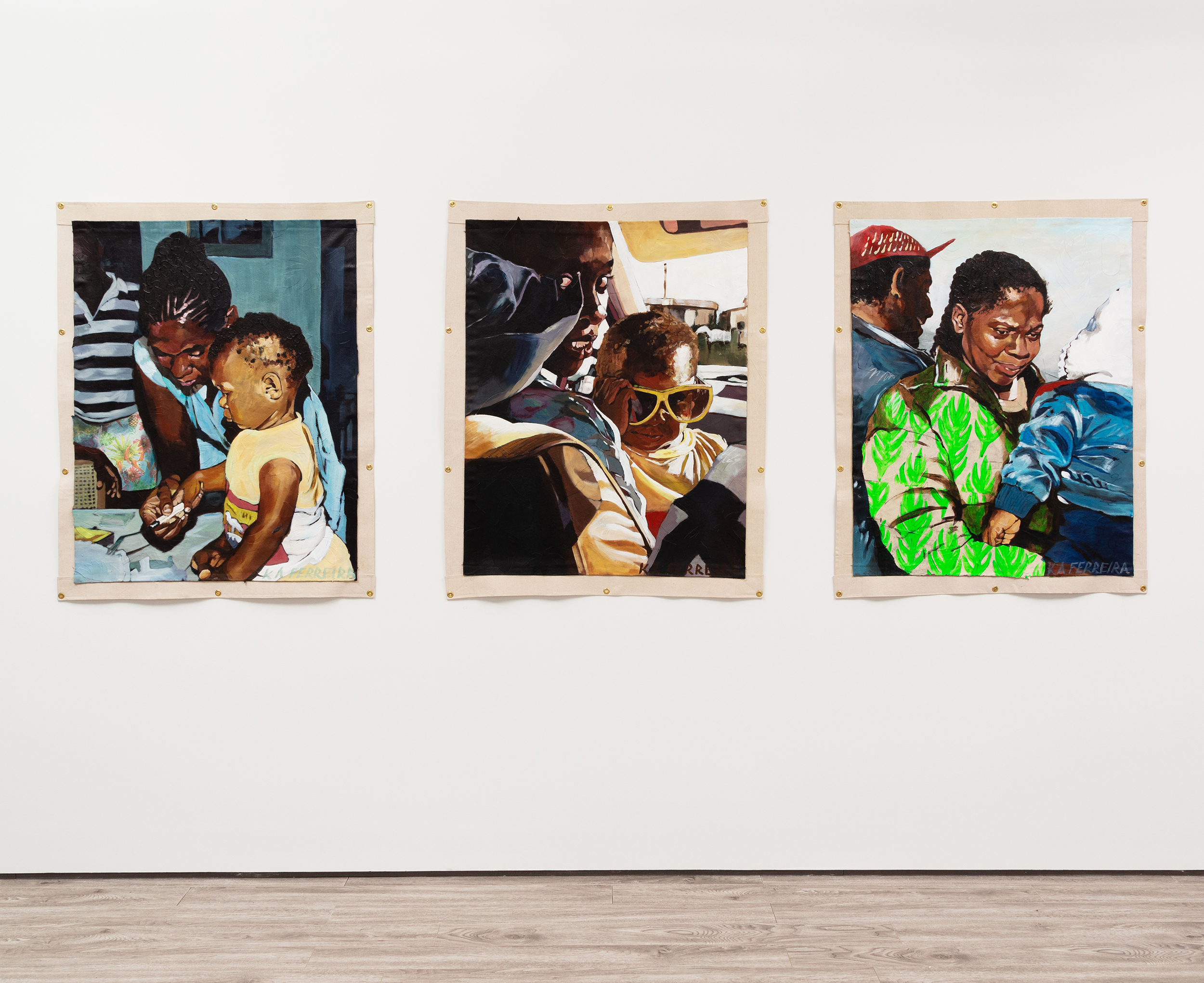
Let’s go back to your dad, Roger Ferreira, for a moment. How did or does his work inform your practice, if at all?
Our work is different in theme, but I can definitely see stylistic things that I’ve picked up from him in the way that I apply paint, and the use of collage in the base of my paintings. I knew these things were possible because I’d seen him do it.
One of my favourite elements of your pieces is the collage aspect and how from any vantage point, new things come into view. Tell me more about that process.
It started with me collaging with fabric; I was working with the idea of home, and how people in North America see the Caribbean. When I would go back to Trinidad for Christmas, people would ask if I was going on vacation and think that the Caribbean is just full of resort-style, commodified tourist attractions, when really I was going to see family for the holidays the same way they would.
I began using the island print, or Hawaiian print, as a sarcastic stand-in for that North American gaze toward the Caribbean that people have. I was cutting up old Hawaiian shirts and collaging with them, or painting from them, and I wondered how I could embed more information into that. I chose identifiable things from these prints like flowers and birds and fish and cut those shapes out of paper to collage on to a canvas that I paint over. But they don’t tie-in specifically with the actual photographic images that I use.
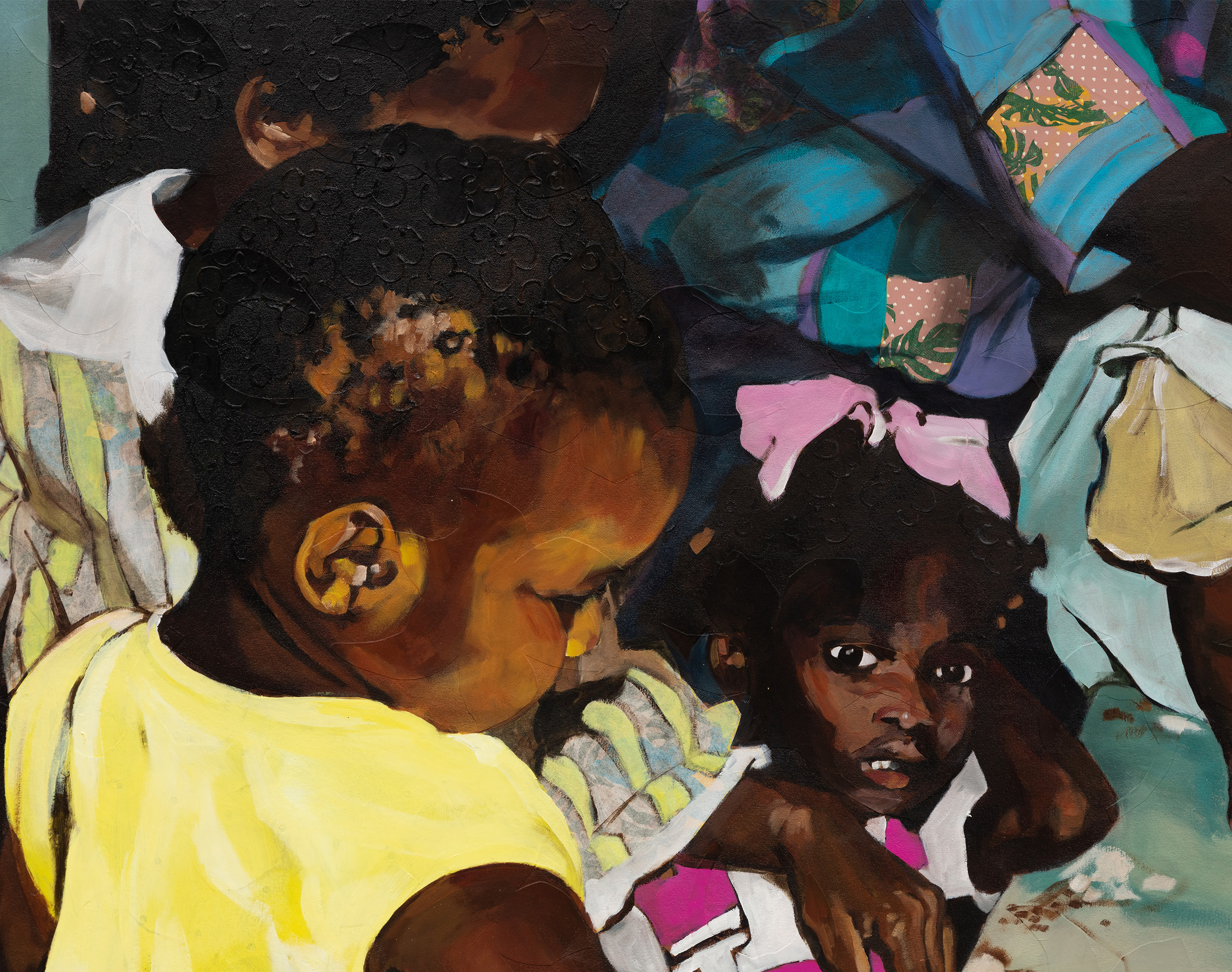
Acrylic and mixed media on canvas
72 in x 91 in.
Let’s talk more about those photos. How do you decide on what you’ll use for a painting?
I have a big database of them scanned into my computer. I either start by picking a theme, or if there’s an image that really stands out to me, I’ll work with it. And if it represents a specific time or event, I’ll go back and pick out more from that period. I look for pictures that have a lot of information that I can pull out.
One thing the exhibition text says so beautifully is that you highlight moments that are both profound and commonplace all at once. This makes me think about the fact that while many of us have these kinds of candid images sitting in a basement, what a lot of us put out into the world now is hyper-curated photography. How does it make you feel to know that the photographs you’re working from aren’t just capturing a specific personal moment in time, but also more generally emphasizing that this was the technology and the method we had to make memories. And it’s so different now. Does that inform your practice at all?
Well, that’s actually leading me into what I want to do next. I still have tons of old photos to work from, luckily; and what would happen is when those photos were printed, one copy would be sent back home to Trinidad. That’s the way we stayed connected because this was obviously before social media. Even then, photos were how we communicated.
Recently I’ve been thinking about making my own documentation and actually photographing images to have a little control over composition. I told a friend I wanted to learn more about digital photography, and he said that while he could teach me how to set up a perfect shot, what’s best about my work is that it’s derived from what was taken with a point-and-shoot camera, where you become part of the process physically in order to get the shot you want.
So, I’ve been going to Value Villages and buying old point-and-shoots. It’s been great – I take them to a camera store to see if they still work and I’ve been getting film for them. Hopefully I can start photographing stuff soon and see how these reference shots are similar to, and different from, what I’ve been working with previously.
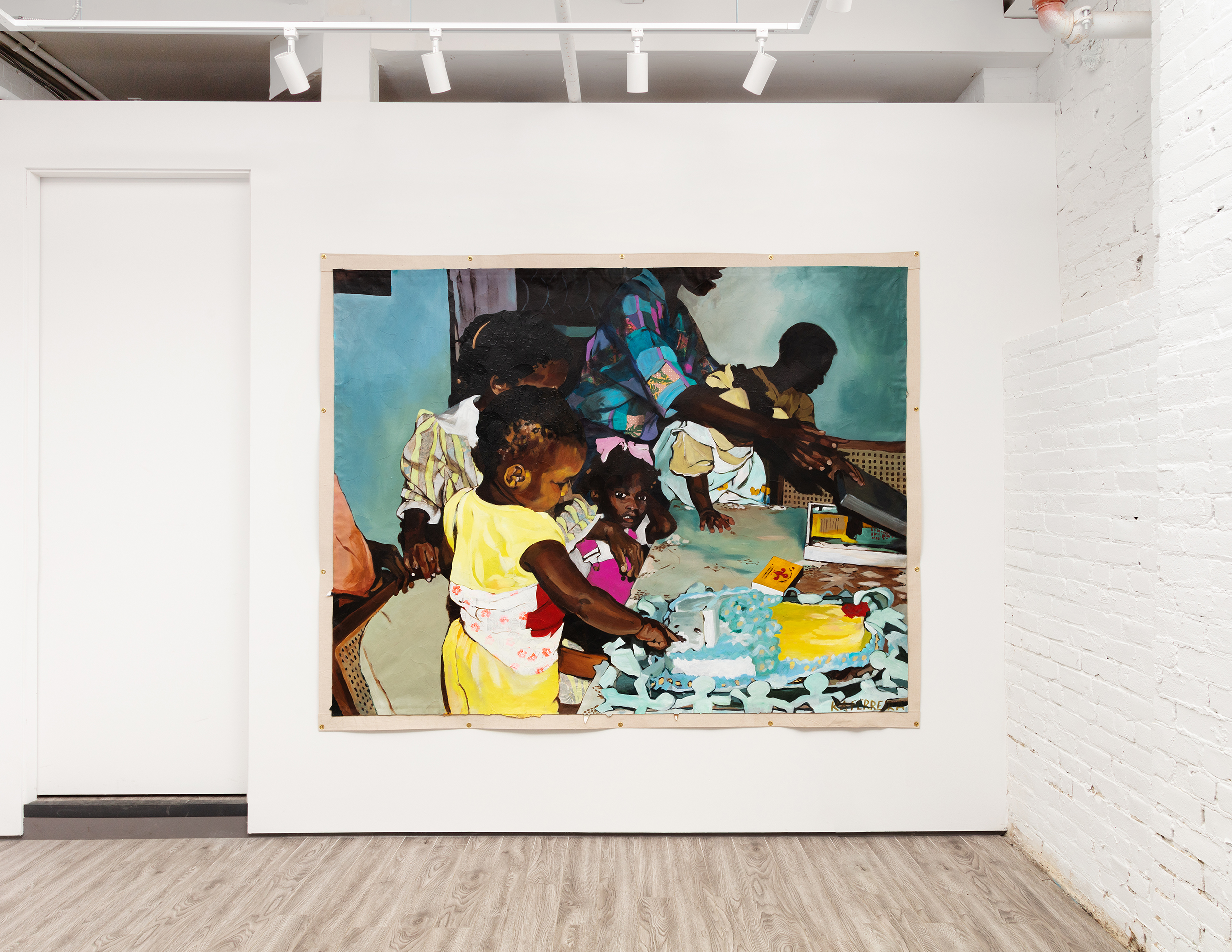
Acrylic and mixed media on canvas
72 in x 91 in.
I wanted to ask you about nostalgia, since your work is quite heavy with it. I don’t always like feeling nostalgic because it can be sad, or full of yearning. What are those feelings like for you looking back at these photos and working on these pieces?
I do think there’s a sad connection with nostalgia, but one that’s also somewhat comforting. A comforting sadness. And I’m okay with that. I understand that things change and will continue to change, but I will glorify what I love and am still connected to.
This interview has been edited and condensed.